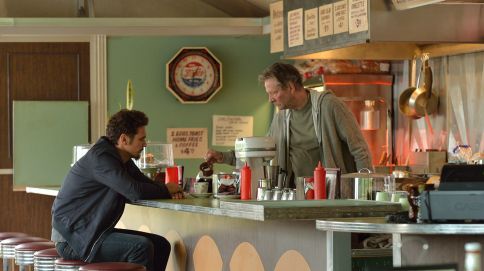
I watched a video recently (see below) of Vonnegut delivering a lecture on the shapes of stories. It is entertaining and insightful, as Vonnegut often is, which made me think that it would be a perfect “Minds On” or “Hook” (or start of the lesson in layperson’s terms) in a unit on Narrative. This video is so approachable, it could be used for grades as young as 4, to as high as 12. First 24 seconds of the video is voiceover, so just skip ahead to get to the good stuff!
Putting narrative structure into a graphic format like this is a wonderful tool for visual learners because they’re able to more easily picture what is happening during major events of a novel (this is a high point, this is the denouement). It is also helpful for students who are more left-brained, logical, math and science-biased, or whatever term works for you, because it shows these students, “look, the study of English is not just feelings and metaphors; there are patterns within literature that are quantifiable.”
With younger grades, I would show them this video, discuss the important points Vonnegut brings up and then leave it mostly at that. If a grade 3 or 4 can recognize the “Man in Hole” or “Boy Meets Girl” plot structure, they are already on their way to being more aware of their own creative writing and the books and movies they consume.
In older grades, perhaps in grade 8 and most definitely by grade 9 and beyond, I would extend the initial conversation Vonnegut introduces to talk in more detail about Joseph Campbell’s Monomyth, also known as The Hero’s Journey. The Hero’s Journey is so essential to truly understanding fiction and the sooner students start to grapple with the concepts, the better.
Why is this important?
Figuring out the standard formulas (or really just the one important formula) in narrative helps make students better writers and readers. Knowing a structure that works will help struggling writers keep the story going and think more deeply about character, conflict, and conclusions. As a reader, students will be able to more easily recognize significant plot points and character archetypes. It will even strengthen their ability to take in and assess pop culture, as movies and TV shows all use the hero’s journey as well. Sometimes the reason why you dislike a book or movie, but can’t quite put your finger on why, is because the writer has inexpertly applied, or even omitted certain elements of the Journey. I love analysing movies for the components of the journey (here the hero is refusing the call to adventure, etc.), but I am a nerd with too much time on her hands, so there’s that.
I’m an advocate of teaching these concepts to students early because the sooner they understand the basic elements of narrative structure, the better they will be at applying those ideas to increasingly abstract applications of that structure. Yes, there are certainly times in movies and books where characters literally “cross a threshold” and leave their normal world behind. For example, in the new time travel show 11/22/63, based off the Stephen King novel of the same name, the protagonist, played by James Franco, urged by an older man (mentor archetype), reluctantly (because he’s refusing the call to adventure) steps into a closet at the diner in the present day and is transported back to the 60s (thus leaving the normal world behind).

Most of the time though, these elements of narrative are done in more subtle or metaphoric ways. Proust crossed a threshold when he ate the madeleine, but it is a psychological threshold into his memory, not a literal geographic location. If you teach students about narrative structure early on, you can introduce some more literal applications of the Hero’s Journey (many myths, speculative fiction, and adventure stories would serve as good examples) before moving on to more complicated narratives in later grades.
The brief video of the Vonnegut lecture is a funny, simple way to start introducing these trickier concepts to students. Try it with some students of your own and let me know if they find it engaging!
No comments:
Post a Comment